Andhra Pradesh Board Class 6th Social Science Chapter 1 Our Earth in the Solar System Textbooks Solutions PDF
Andhra Pradesh State Board STD 6th Social Science Chapter 1 Our Earth in the Solar System Books Solutions with Answers are prepared and published by the Andhra Pradesh Board Publishers. It is an autonomous organization to advise and assist qualitative improvements in school education. If you are in search of AP Board Class 6th Social Science Chapter 1 Our Earth in the Solar System Books Answers Solutions, then you are in the right place. Here is a complete hub of Andhra Pradesh State Board Class 6th Social Science Chapter 1 Our Earth in the Solar System solutions that are available here for free PDF downloads to help students for their adequate preparation. You can find all the subjects of Andhra Pradesh Board STD 6th Social Science Chapter 1 Our Earth in the Solar System Textbooks. These Andhra Pradesh State Board Class 6th Social Science Chapter 1 Our Earth in the Solar System Textbooks Solutions English PDF will be helpful for effective education, and a maximum number of questions in exams are chosen from Andhra Pradesh Board.Andhra Pradesh State Board Class 6th Social Science Chapter 1 Our Earth in the Solar System Books Solutions
| Board | AP Board |
| Materials | Textbook Solutions/Guide |
| Format | DOC/PDF |
| Class | 6th |
| Subject | Social Science |
| Chapters | Social Science Chapter 1 Our Earth in the Solar System |
| Provider | Hsslive |
How to download Andhra Pradesh Board Class 6th Social Science Chapter 1 Our Earth in the Solar System Textbook Solutions Answers PDF Online?
- Visit our website - Hsslive
- Click on the Andhra Pradesh Board Class 6th Social Science Chapter 1 Our Earth in the Solar System Answers.
- Look for your Andhra Pradesh Board STD 6th Social Science Chapter 1 Our Earth in the Solar System Textbooks PDF.
- Now download or read the Andhra Pradesh Board Class 6th Social Science Chapter 1 Our Earth in the Solar System Textbook Solutions for PDF Free.
AP Board Class 6th Social Science Chapter 1 Our Earth in the Solar System Textbooks Solutions with Answer PDF Download
Find below the list of all AP Board Class 6th Social Science Chapter 1 Our Earth in the Solar System Textbook Solutions for PDF’s for you to download and prepare for the upcoming exams:Question 1.
How does a planet differ from a star?
Answer:
Stars have their own heat and light and planets have to depend on stars for light and heat.
Question 2.
What is meant by the ‘Solar system’?
Answer:
The eight planets which revolve around the sun, satellites and other celestial bodies are together known as‘Solar System’.
Question 3.
Why is life not possible on all planets?
Answer:
The Earth has all the three components such as lithosphere, hydrosphere and atmosphere which makes life possible. The remaining planets do not consist of these components. So life is not possible on all planets.
Question 4.
Why do we always see only one side of the moon?
Answer:
The moon moves around the earth and spin on its own also. So we can see only one side of the moon always.
Question 5.
What is the Universe?
Answer:
Millions of Milkyway galaxies including the solar system together is called the Universe.
Question 6.
Air and water are essential to life on the earth. But now they are being polluted by humans. What happens to the life of humans on this earth if pollution increases further?
Answer:
Pollution contains toxins that adversely impact living creatures within them. Rising pollution will lead to premature aging. Human exposure to toxins will increase to a great extent if pollution is not controlled. This pollution is directly linked to cancer and heart diseases.
Question 7.
Scientists are now trying to explore more about the moon and other planets. Do you think their efforts benefit us?
Answer:
The efforts of scientists in exploring the moon and other planets definitely useful to us. Space exploration alone provides us a significant amount of knowledge which is important for the education of people also about our planet and universe. It increases the knowledge about space and the discovery of distant planets and galaxies and gives us an insight into the beginnings of our universe.
Question 8.
Observe figure 1.4 (text book Page No. 5) and fill in the table.
Answer:
| SI. No | Name of the Planet | Distance from the Sun in Kilometres | No. of Moons |
| 1. | Mercury | 58,000,000 | — |
| 2. | Venus | 108,000,000 | — |
| 3. | Earth | 150,000,000 | 1 |
| 4. | Mars | 228,000,000 | 2 |
| 5. | Jupiter | 778,000,000 | 79 |
| 6. | Saturn | 1,427,000,000 | 82 |
| 7. | Uranus | 2,869,000,000 | 27 |
| 8. | Neptune | 4,496,000,000 | 14 |
Project Work
Prepare a model of the solar system.
Answer:
Student Activity.
Choose the correct answer.
1. Though tremendous heat is emitted by the Sun, why do we receive only limited heat?
A) Sun is very far from the Earth
B) Sun is very small when compared with the Earth
C) Sun is very close to the Earth
D) None of these
Answer:
A) Sun is very far from the Earth
2. The planet is known as the “Earth’s Twin” is
A) Jupiter
B) Saturn
C) Venus
D) Aries
Answer:
C) Venus
3. Which is the third nearest planet to the sun?
A) Venus
B) Earth
C) Mercury
D) Jupiter
Answer:
B) Earth
4. All the planets move around the Sun in a
A) Circular path
B) Rectangular path
C) Elongated path
D) Square path
Answer:
C) Elongated path
5. Asteroids are found in between the orbits of
A) Saturn and Jupiter
B) Mars and Jupiter
C) The Earth and Mars
D) Uranus & Neptune
Answer:
B) Mars and Jupiter
Match the following:
1. Blue Planet [ ] a) Mars
2. Farthest Planet to Sun [ ] b) Neptune
3. Fourth Planet from Sun [ ] c) Mercury
4. Nearest Planet to Sun [ ] d) Earth
Answer:
1. Blue Planet [ D ] a) Mars
2. Farthest Planet to Sun [ B ] b) Neptune
3. Fourth Planet from Sun [ A ] c) Mercury
4. Nearest Planet to Sun [ C ] d) Earth
Let’s do
Solve the puzzle with the terms defined in the following statements.
CROSS:
- The cluster of millions of Stars. – Galaxy
- The natural satellite of the Earth. – Moon
- The ringed planet (See figure 1.4). – Saturn
- The sphere of water. – Hydrosphere
- The celestial object is made up of a head and a tail. – Comet
DOWN:
- The shape of the Earth. – Geoid
- The closest star to the earth. – Sun
- The path of the planets that move around the Sun. – Orbit
- The sphere of gases that surrounds the Earth. – Atmosphere
- The small pieces of celestial bodies, move around the Sun between Mars and Jupiter.
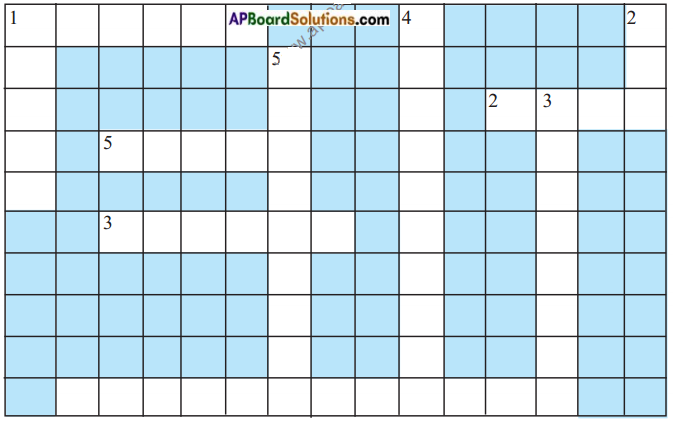
Answer:
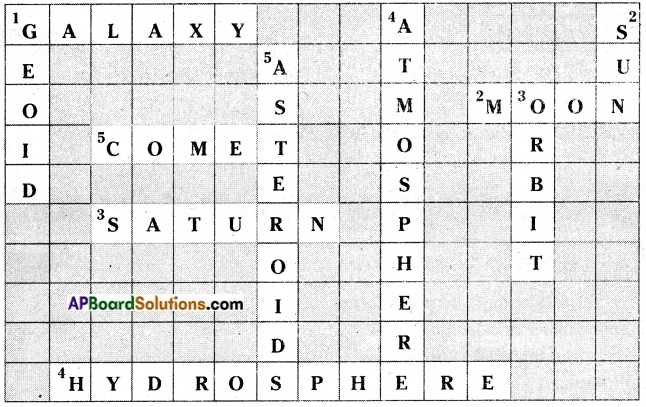
Let’s do
You might have heard that people make human chains and run for world peace etc. You can also make a Solar system and run for fun by using the following steps.
Step – 1: All children of your class can play this game. Assemble in a big hall or on a playground.
Step – 2: Now draw eight circles on the ground. Draw all circles in the same manner.
Step – 3: Prepare 10 placards. Name them as Sun, Moon, Mercury, Venus, Earth, Mars, Jupiter, Saturn, Uranus, Neptune.
Step – 4: Select 10 children in the following order and give each one of them a placard.
Order of placard distribution
- The Sun – tallest, The Moon – smallest; Mercury, Mars, Venus, and Earth(almost equal heights); Neptune, Uranus, Saturn, and Jupiter taller than the earlier four Planets but smaller than the Sun.
- Now ask the children holding placards to take their places with the Sun in the cent rein their orbits. Ask the child holding the Moon placard to keep the hand of the child holding the Earth placard always.
- Now your Solar system is almost ready to go into action.
- Now make everybody move slowly in the anti-clockwise direction. Your class has turned into a small human replica of the Solar system.
- While moving in your orbit you can also turn around. For every celestial body, the spin should be anti-clockwise except for Venus and Uranus who will make the spin in the clockwise direction.
Answer:
Student Activity.
Field Visit
Question 1.
Observe the video of Planetarium in the QR Code. Describe your experiences.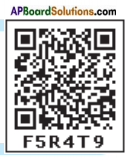
Answer:
Student Activity.
Question 2.
Visit SHAR which is located in SPSR Nellore District.
Answer:
Student Activity.
6th Class Social Studies 1st Lesson Our Earth in the Solar System InText Questions and Answers
Let’s Do
(Textbook Page No. 3)
Question 1.
To know how days and nights occur
Answer:
Let us observe celestial bodies:
Required material: Torch, a sheet of plain paper, pencil and a needle.
Process:
- Place the torch in the centre of the paper with its glass front touching the paper.
- Now draw a circle around the torch.
- Perforate the paper with the needle within the circled area.
- Now place the perforated circle part of the paper on the glass front and wrap the paper around the torch with a rubber band.
- In a dark room, stand at some distance facing a plain wall. Switch off all other lights. Now flash the torchlight on the wall. You will see numerous dots of light on the wall, which look like stars at night.
- Switch on all the lights in the room. All dots of light will be almost invisible.
- You may now compare the situation with what happens to the bright objects of the night sky after the Sun rises in the morning.
Answer:
Student Activity.
Question 2.
Observe the following picture and name the planets in the boxes given below. (Textbook Page No. 6)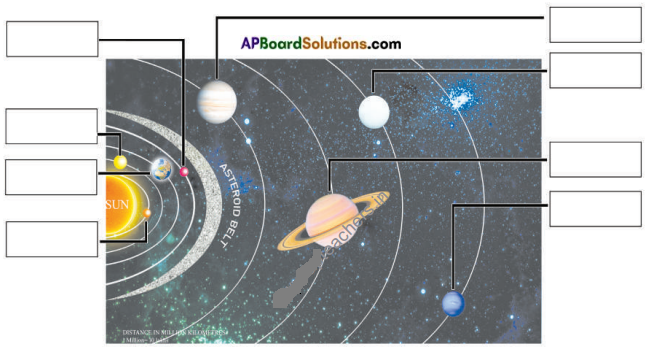
Answer: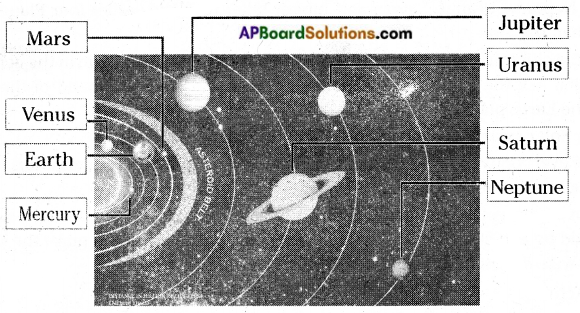
Think and Respond
Question 1.
From ancient times people worship the Sim as God. Give reasons. (Textbook Page No. 4)
Answer:
Sun is glorified in the Vedas of ancient India as an all-seeing god who observes both good and evil victims. The Sun is the source of all life on our planet. Without the Sun we couldn’t be here. Sun is the only natural source of energy. So people in ancient times treated the Sun as a god and we worship him.
Question 2.
What do animals and plants require in order to grow and survive? (Textbook Page No. 6)
Answer:
To grow and survive animals need air, water, food and shelter. To grow and survive plants require air, water, nutrients and light.
Question 3.
How can you say that our earth is a unique planet in the solar system? (Textbook Page No. 7)
Answer:
Earth is a unique planet for many reasons. They are:
- Earth is the only planet that supports animal or plants life.
- Earth’s location maintains the right temperature which is important for life forms.
- Human beings in-universe is found only on the Earth,
Question 4.
How is man-made satellites useful to mankind? Discuss. (Textbook Page No. 9)
Answer:
A satellite is an object that orbits another object. They are natural and man-made. Moon is a natural satellite of the Earth. Satellites are used for many purposes. They are weather satellites, communication satellites, navigation satellites, astronomy satellites and many other kinds.
- They are used for communication purposes.
- Carry instruments or passengers to perform experiments in space.
- For weather forecasting system.
- For global positioning system. (GPS).
Question 5.
Can you relate yourself to the Universe now? You are on the Earth and the Earth is a part of the Solar system. Our Solar system is a part of the Milky Way or Galaxy which is part of the Universe. Think of the fact that the Universe contains millions of such galaxies. How do you fit in the picture? How tiny you are? Think a while. (Textbook Page No. 11)
Answer:
Student Activity.
Explore
Question 1.
Browse the following website and know more about the solar system. (Textbook Page No. 5) https://spaceplace.nasa.gov/menu/solarsystem/.
Answer:
Student Activity.
Question 2.
Up to 2006, there were 9 planets in our Solar system. But now we have only 8 planets. What was the 9th planet? What happened to it? Find out the reasons with the help of your teacher? (Textbook Page No. 6)
Answer:
Up to 2006, we considered there are 9 planets in our solar system.
They are:
- Mercury,
- Venus,
- Earth,
- Mars,
- Jupiter,
- Saturn,
- Uranus,
- Neptune,
- Pluto.
In 2006 the International Astronomical Union decided that Pluto is not having the technical qualities of a planet and reduced the number of planets from 9 to 8.
Question 3.
Who is the first Indian astronaut to go into space? (Textbook Page No. 8)
Answer:
Rakesh Sharma was the first Indian Astronaut to travel into space. He was part of the Soviet Union’s Soyuz T-11 expedition, which was launched on April 2, 1984.
Question 4.
Have you heard of Chandrayan-1 and Chandrayan-2? Try to know about them and discuss in class. (Textbook Page No. 8)
Answer:
Chandrayaan is India’s moon mission. Chandra means the moon and yarn is a vehicle. Chandrayaan means Lunar Space Craft.
Chandrayaan -1 was India’s first moon mission. Chandrayaan -1 was launched in 2008 from Satish Dhawan Space Centre, Sriharikota.
Chandrayaan – 2 is the second moon mission developed by the Indian Space Research Organisation. It was launched in September 2019 from Satish Dhawan Space Centre, Sriharikota.
AP Board Textbook Solutions PDF for Class 6th Social Science
- AP Board Class 6
- AP Board Class 6 Social Science
- AP Board Class 6 Social Science Chapter 1 Our Earth in the Solar System
- AP Board Class 6 Social Science Chapter 2 Globe Model of the Earth
- AP Board Class 6 Social Science Chapter 3 Maps
- AP Board Class 6 Social Science Chapter 4 Land Forms Andhra Pradesh
- AP Board Class 6 Social Science Chapter 5 Early Life to Settled Life
- AP Board Class 6 Social Science Chapter 6 Early Civilisations
- AP Board Class 6 Social Science Chapter 7 Emergence of Kingdoms and Republics
- AP Board Class 6 Social Science Chapter 8 Kingdoms and Empires
- AP Board Class 6 Social Science Chapter 9 Government
- AP Board Class 6 Social Science Chapter 10 Local Self Government
- AP Board Class 6 Social Science Chapter 11 Indian Culture Languages and Religions
- AP Board Class 6 Social Science Chapter 12 Towards Equality
- AP Board Class 6 Social Science Chapter 1 సౌర కుటుంబంలో మన భూమి
- AP Board Class 6 Social Science Chapter 2 గ్లోబు – భూమికి నమూనా
- AP Board Class 6 Social Science Chapter 3 పటములు
- AP Board Class 6 Social Science Chapter 4 ఆంధ్రప్రదేశ్ – భూస్వరూపాలు
- AP Board Class 6 Social Science Chapter 5 సంచార జీవనం నుండి స్థిర జీవనం
- AP Board Class 6 Social Science Chapter 6 తొలి నాగరికతలు
- AP Board Class 6 Social Science Chapter 7 సామ్రాజ్యాలు, గణతంత్రాల ఆవిర్భావం
- AP Board Class 6 Social Science Chapter 8 రాజ్యాలు మరియు సామ్రాజ్యాలు
- AP Board Class 6 Social Science Chapter 9 ప్రభుత్వం
- AP Board Class 6 Social Science Chapter 10 స్థానిక స్వపరిపాలన
- AP Board Class 6 Social Science Chapter 11 భారతీయ సంస్కృతి, భాషలు మరియు మతాలు
- AP Board Class 6 Social Science Chapter 12 సమానత్వం వైపు







0 Comments:
Post a Comment